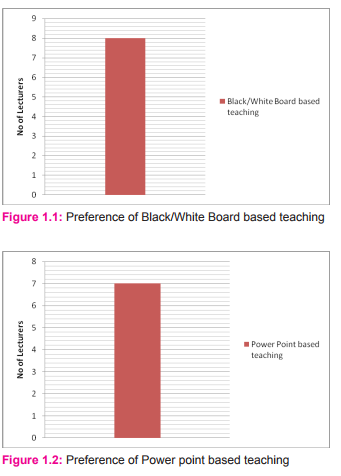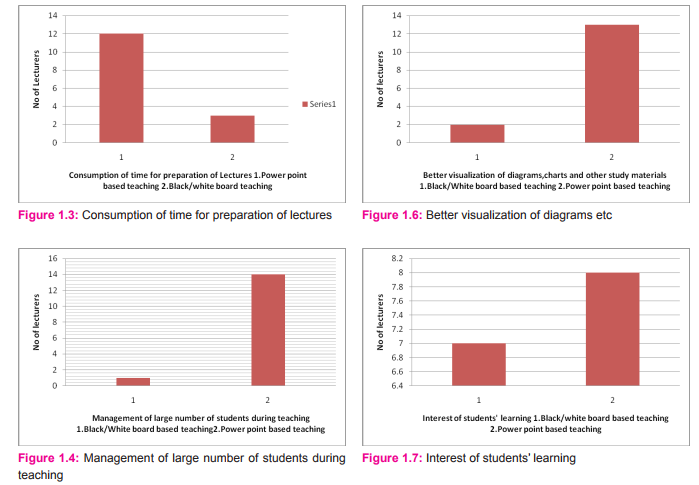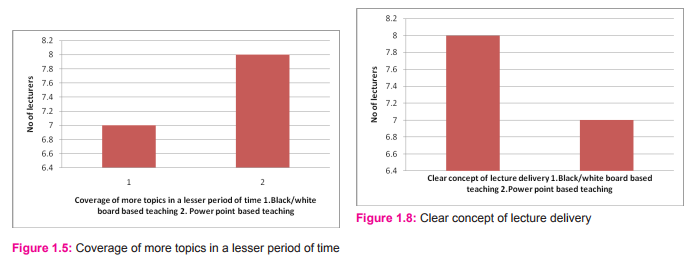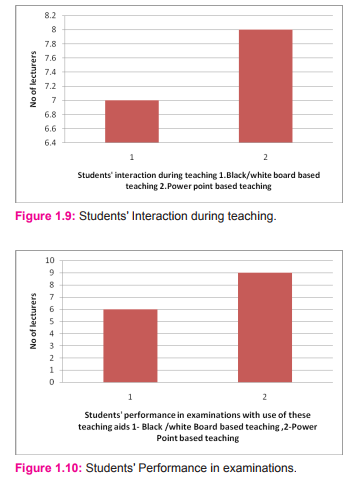IJCRR - 8(13), July, 2016
Pages: 01-05
Date of Publication: 12-Jul-2016
Print Article
Download XML Download PDF
EFFECTIVENESS OF USING POWER POINT BASED TEACHING VS. BLACK/WHITE BOARD BASED TEACHING AMONG PHYSIOTHERAPY LECTURERS IN LOVELY PROFESSIONAL UNIVERSITY - A PILOT STUDY
Author: T. S. Muthukumar
Category: Healthcare
Abstract:Aims: The typical undergraduate and post graduate student of today is accustomed to receiving information on a daily basis in a variety of formats, i.e. multimedia channels. This can lead to teachers to update themselves constantly to enrich the students' knowledge.
Methodology: Physiotherapy lecturers working in Lovely Professional University were participated in this pilot study and convenient sampling method was incorporated. The participants were asked to answer the questionnaires and the responses were collected by the researcher and depicted in a graph.
Results and Conclusion: The overriding conclusion would be that pedagogy must drive educational technology usage rather than the reverse. Since it was a pilot study, the lack of generasibility enables the future research to focus on which instructional devices would be helpful to the physiotherapy teaching community.
Keywords: Power point, Black/ white board, Learning management system (LMS)
Full Text:
INTRODUCTION
Advances in the development of technology enable teaching profession to explore new methodologies for teaching and learning. These efforts catalyzed the process of integrating technology-mediated tools in education. Such mutually induced supply demand chain greatly influenced different models of teaching and learning, thereby creating an interdependent learning environment.1 Different modes of teaching and learning in the form of online, distance, mobile and network learning environments motivated and to an extent compelled faculty to develop and deliver online teaching materials (Georgiev, Georgieva and Smrikarov, 2006)2 . Physiotherapy is one of the professions that need update in recent years. In earlier days, the Physiotherapy lecturers adopted the black board method of teaching and it helped them to deliver the lectures in an appropriate method. Recently with the introduction of learning management system (LMS) in flexible learning environments, Physiotherapy teachers may develop and deliver course materials for students. According to Quarless (2007), the growing prevalence of LMS is providing more opportunities in tertiary education by mainly exploring design of integrated systems for better suitability in online learning environments and he emphasized the main functions of any LMS such as Course administration and management, Course Pedagogy Teaching and Learning3 . Graves (2001) suggested that there are two main reasons for education providers to adopt e- learning tools4 : 1) To improve the traditional classroom environment with web based technologies with flexibility for access of web based course materials and communication 2) To implement the concept of distance education where there is no traditional class environment and minimize the classroom time. However, it is still a challenge for teachers to adopt the new course delivery formats in spite of the support or training provided by their management (Perreault, Waldman and Zhao, 2002)5 .
There exists a dilemma among the Physiotherapy fraternity that which system of teaching methodologies such as Black board based teaching or Power point based teaching suitable for them. In other words it is older people vs. next gen because the recent Physiotherapy graduates easily transformed themselves to a changing teaching methodology environment. The purpose of this pilot study is to find out the use of black/ white board based teaching and power point based teaching among the Physiotherapy lecturers working in Department of Physiotherapy Lovely Professional University. This study is first of its kind among the Physiotherapy fraternity and it will moot others to go deep into it.
MATERIALS AND METHODOLOGY
The present study was a pilot study in that the participants were selected conveniently among the Physiotherapy lecturers working in department of Physiotherapy, Lovely Professional University. The inclusion criteria was lecturers who were taking Physiotherapy subjects for both undergraduate and post graduate students irrespective of the age, sex, experience and higher qualification and there was no specific exclusion criteria. The size of the population was 15 lecturers. Informed consent was obtained and the participants were asked to answer the questions submitted to them. The questionnaire consists of 10 questions, each question has two options and the respondents were asked to mark or circle the desired answers. The time has given to answer the questions was 15 minutes. The questionnaire has categories like preference of black/white board teaching vs. power point teaching, consuming time and effort, management of large number of students, bothersome/tiring for the preparation of a lecture, coverage of more topics in a lesser time, presenting diagrams, charts, students’ interest, and clear concept of lectures, students’ interaction and students’ performance. The research methodology involved in this study was simple graphical representations of categories that the participants had chosen. In this research, the pilot study had been employed because of estimation of larger number of samples in future research and the feasibility of further research. The concise Oxford Thesaurus defines a pilot project study as an experimental, exploratory, test, preliminary, trial or tries out investigation and investigation designed to test the feasibility of methods and procedures for later use on a large-scale or to search for possible effects and associations that may be worth following up in a subsequent larger study. The data collected from the respondents were graphically illustrated using bar diagrams and the analysis was done at the confidence interval (CI) of 95%.
RESULTS
The findings in this study were inconclusive since it was a pilot study. Most of the respondents about 60% choose preference over black/white board teaching than power point based teaching. The majority of the participants felt more time was consumed to prepare power point presentations. More number of lecturers about 90% preferred power point presentation to teach large number of students rather than black/white board teaching. Many of the participants acknowledged power point presentation was helpful to visualize diagrams, photos videos, better than black/white board teaching. The results were displayed as graphs. The results could not be generalized because of the small sample size. More variables and also the students’ feedback might be needed in future studies.




DISCUSSION
Technology Acceptance Model (TAM)7 originally designed by Davis (1989) has became popular as one of the theories to evaluate any information system’s user understanding and evaluated the decision factors and perceptions about how and when the technology tool is used. Although the initial stages of using and understanding teaching tools such as Blackboard is dependent on its ease of use, it is the usefulness of the system and the support by the organization that have the major impact. In this technology driven educational world, the transformation from black/white board based teaching to power point based teaching has been increasing since most private universities adopt LMS. The present study gave a little idea about the usage of black/ white board teaching or power point teaching among the Physiotherapy lecturers. Out of the 15 respondents, 60% percentage of the people preferred the usage of black/white board teaching because they said that it is easy to use. If compared in terms of time consumption for the preparation of lectures, more than 90% of the participants casted their vote to power point based teaching than black/white board teaching. Majority of the lecturers (99%) preferred power point based teaching to manage the large number of students because they felt that good view of the power point slides using LCD projectors. More than 60% of the participants said that power point consumes more time to prepare for a single lecture and it is tiring. The black/white board based teaching and power point based teaching shared the equal share (more or less) when compared in terms of clear concept of lecture delivery, coverage of more topics in a lesser period of time, interest of students? learning and students? interaction during teaching. It was evident in this study that 95% of the participants had chosen power point based teaching for better delivery of lectures when it requires photographs, pictures and diagrams. Taking into account of the students? performance in test or examinations after the lectures were over, 70% of the participants selected power point based teaching since they believed that it was easily understood by the students and its retention of use during the time of examination preparation. Now-a- days, the Physiotherapy lecturers are updating themselves regarding the new technology available for treatment and also in education field. It is the interest and involvement of the individual to adopt new systems of technology during the course of their life. The study of Landry8 (2003) validated the application of TAM theory in educational environment and identified the influence of external variables such as the instructor’s computer background, computer literacy and perceived ease of use etc Perceived ease of use as defined by Davis (1989) is the degree to which a person believes that using a particular system would be free from effort. Davis (1989) defined PU as “the degree to which a person believes that using a system would enhance his or her job Performance” and referred to the capability of software application to be used advantageously7 . Black/white board based teaching was adopted by numerous teachers in olden days and also recently. They believed that the teaching should be conducted thorough black/white board method only. In course management systems, Blackboard has become a „”glorified toolkit” to meet the demands at the teaching level as “there is the desire to promote active learning and perhaps employ cooperative/collaborative learning strategies and online learning assessments that offer timely feedback to student and instructor alike” according to Quarless, (2007).3 As per Tannenbum9 (1998) power point has all the multimedia components such as sound, video, texts and animations etc. Based on the literatures available regarding the use of power point based teaching, one can get mixed responses. Nunberg10 (1999) stated that PowerPoint is denounced by academics and CEOs for causing detrimental effects on “dialogue, interaction, and thoughtful consideration of ideas.” After a review of these studies, Craig and Amernic11 (2006) concluded that PowerPoint?s effectiveness is contingent upon the discipline, the learning objectives, and learner types. They recommended that faculty study new technology first rather than accepting them blindly and unquestiongly. Hence this study presented all the merits and demerits of both the form of teaching methods. The main limitation of the study was minimal categories we included in the questionnaire and open ended type of questions would have included in the main study.
CONCLUSION
The present study was first of its kind since no research was carried out among Physiotherapy fraternity. Based on the findings, the lecturers preferred black/white board teaching or power point based teaching based on their convenience and other features. It may be concluded that this study was a pilot study and it enables the future research to add more categories in the questionnaire and elaborately study the outcomes of both forms of teaching. In a nutshell it is inconclusive to generalize the preference of usage of black/white board teaching or power point based- teaching among the Physiotherapy fraternity.
ACKNOWLEDGEMENT
Author acknowledges the immense help received from the scholars whose articles are cited and included in the references of this manuscript. The author is so grateful to authors/ editors/publishers of all those articles journals and books from where the literature for this article has been reviewed and discussed. Ethical committee Approval: This study has been approved by ethical committee of Lovely
Professional University Funding: There is no source of fund from any external agency Conflict of Interest: There is no conflict of interest.
References:
1. Missula, Saroja, “Staff perceptions of Blackboard as an online teaching tool in tertiary education” (2008). School of Computing and Information Technology Dissertations and Theses. Paper 12.http://www.coda.ac.nz/unitec_scit_di/12.
2. Georgiev, T., Georgieva, E., and Smrikarov, A. (2006). M-Learning - A new stage of e- Learning.Proceedings of International Conference on Computer Systems and Technologies CompSysTech’2004 .Retrieved Nov 25 2010, http://ecet.ecs.ru.acad.bg/ cst04/Docs/sIV/428.pdf.
3. Quarless, D. A. (2007). Redundant features of design in Blackboard (LMS) and user error. SIGCSE Bull, 39(2), 177-179. 4. Graves, W. H. 2001. The new challenges of E-learning. Ubiquity, 1 (43).
5. Perreault, H., Waldman, L., and Zhao, M. (2002). Overcoming barriers to successful delivery of distance-learning courses. Journal of Education for Business, July/August,313-318.
6. Waite M: Concise Oxford Thesaurus Oxford, England: Oxford University Press, 2 2002.
7. Davis, F. D. (1989). Perceived usefulness, perceived ease of use, and user acceptance of information technology. MIS Quarterly, 13, 31-340.
8. Landry, B., J. (2003). Student reactions to web enhanced instructional elements. AnnArbor MI: ProQuest.
9. Tannenbaum, Robert S. 1998. Theoretical foundations of multimedia. New York: Computer Science Press
10. Gregory Krippel, A James Mckee, Janette Moody, Multimedia use in Higher education: promises and pitfalls Journal of Instructional pedagogies. Retrieved Nov 25 2010 http://www. aabri.com/manuscripts/09329.pdf.
11. Craig, Russel J. and Joel H. Amernic. 2006. PowerPoint presentation technology and the dynamics of teaching. Innovation in Higher Education. Vol. 31 147:160.
|






 This work is licensed under a Creative Commons Attribution-NonCommercial 4.0 International License
This work is licensed under a Creative Commons Attribution-NonCommercial 4.0 International License